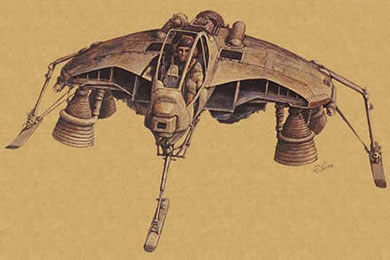|

|
| Niebelungen Armored Wepon Factory |
| 1,101 - 1,984 |
| 1 |
| 4.43 tons |
| 5.76 m |
| 5.41 m |
| 1.83 m |
| Jumo 004A/n |
| 825 kph |
| 2,300 km |
| FuG40/a-1 |
| KgZF24, KgZ24/fa |
| 2x 14.5 mm MG313 Machine Guns |
| |
| 20 mm with 5 mm tungsten
5 mm special heatproof ceramic armour |
Image copyright by Kow Yokoyama.
|
On the early morning of March 1, 2875, the high officials of the
Shutoral forces stood
and watched a strange new craft ascending rapidly into the sun.
Averting their eyes because of the blinding glare, the craft swooped
low over the field and then abruptly started ascending again, showing
off its excellent climb rate to the small group of spectators.
Realising the potential of the X-PK40, it was immediately ordered into
production the following day. It was soon adopted as the primary air
weapon of the Shutoral forces, and on September 2882, Shutoral forces
raided the Earth where it fought against the Mercenaries own copy of
the PK40, code name J-40 (S).
The PK40 was designed as fighter/reconnaissance plane. With its
jump-jets mounted under the wings, the craft had good manoeuvrability.
It was also armoured enough to withstand a most machine gun fire of the
time. It gained a good reputation with front line troops and was
produced until September, 2884. While it had a fixed armament of twin
14.5 mm machine guns, it could also mount additional rockets and bombs
under the wings.
The Mercenary troops also used the PK40, although they renamed it the
J-40 (S). They got their initial planes from the defecting Foreign
Legion troops. As the Foreign Legion only had around 70 planes, these
were placed into a new Air Wing - the 53rd Air Wing, which was the
principle air support unit of the Mercenary forces at the beginning of
the war. Because the J-40 (S) was identical to the PK40 (and pretty
much the PK41), the Mercenaries painted their wing tips yellow for
identification. This practise continued until the Mercenaries stopped
producing the plane in September 2885, by that time the Falke was then
entering service.
During 2885,
cargoes started to be transported to the many theatres of war across
the Earth by sea, and these usually travelled further afield than the
normal cruising range of most aircraft. As these convoys contained
troops and equipment for battle, they needed to be protected wherever
possible. This was highlighted when a Shutoral convoy came under attack
by Mercenary J-40 (S) which had been carried out to sea by a converted
freighter which had had a landing deck installed at the front. Because
of this attack, Shutoral forces started to construct their own aircraft
carriers and looked to the PK40 as their principle aircraft from which
to operate from these craft. Adding floatation devices to enable it to
float for brief times further modified the PK40. Additional equipment
for pilot survival was added, such as a rubber raft and survival kit.
However, these plans (and carrier construction) were halted with the
large operation of September of that year, and the PK40T were deemed
surplus to requirements. Additional sea worthy fighter aircraft were
modelled on the PK41 to make the PK41T and these were launched by
catapult from freighters instead of dedicated fighter carriers.
Due to the dust and sand
that comes from the desert, some PK40's had problems adjusting to the
terrain. As a result, some were modified for desert fighting by the
addition of various filters on the air intakes and fuselage. These made
the revised PK40 - the PK40 bis - slightly wider, but other than that,
there were no real appearance differences. Performance and
manoeuvrability didn't suffer at all, but the PK40 bis did develop the
fault that at low speeds, the engine could suddenly cut out. The
Shutoral PK40 bis was more efficient than the Mercenary answer to the
desert - the J-40 Si.
The J-40 Si was the
Mercenary response to desert conditions. Like the PK40 bis, the plane
mounted large air filters around the intakes and the fuselage. While
allowing the craft to then function normally in the desert, because the
air filters were quite large, manoeuvrability suffered when compared to
the PK40 bis.